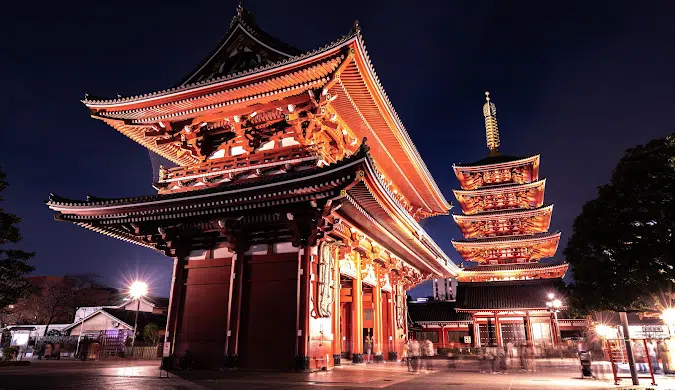In **Tokyo**, sustainability is not a modern trend, but an expression that [combines nature](https://noticiasambientales.com/turismo/asombroso-en-esta-playa-de-japon-se-juntan-la-nieve-la-arena-y-el-mar/) with Japanese tradition and its traditional values. Inspired by the *mottainai* philosophy that rejects waste, the Japanese capital integrates [ecological practices](https://noticiasambientales.com/turismo/asombroso-en-esta-playa-de-japon-se-juntan-la-nieve-la-arena-y-el-mar/) in key sectors of its economy and culture. From temporary housing to haute cuisine, respect for resources defines the urban experience.
Tourist apartments, luxury hotels, and restaurants are redesigning their proposals based on [efficiency and circular economy criteria](https://noticiasambientales.com/turismo/asombroso-en-esta-playa-de-japon-se-juntan-la-nieve-la-arena-y-el-mar/). This transformation is not only a response to imposed policies but a collective culture that understands that [caring for the environment](https://noticiasambientales.com/turismo/asombroso-en-esta-playa-de-japon-se-juntan-la-nieve-la-arena-y-el-mar/) begins in the daily life. **Separating waste**, using **clean energy**, or **reducing plastic** are no longer exceptions but shared norms.
Companies like *Blueground Japan* are investing in housing adapted to new traveler profiles, such as digital nomads. These units not only [reduce energy consumption](https://noticiasambientales.com/turismo/asombroso-en-esta-playa-de-japon-se-juntan-la-nieve-la-arena-y-el-mar/) but also offer multilingual support to guide visitors in local [sustainability practices](https://noticiasambientales.com/turismo/asombroso-en-esta-playa-de-japon-se-juntan-la-nieve-la-arena-y-el-mar/). Thus, tourism becomes a vehicle for transmitting [environmental values](https://noticiasambientales.com/turismo/asombroso-en-esta-playa-de-japon-se-juntan-la-nieve-la-arena-y-el-mar/).
**Environmental awareness** also extends to the most emblematic hotels. Establishments like the Palace Hotel Tokyo implement closed circuits where [organic waste](https://noticiasambientales.com/turismo/asombroso-en-esta-playa-de-japon-se-juntan-la-nieve-la-arena-y-el-mar/) is converted into [fertilizers](https://noticiasambientales.com/turismo/asombroso-en-esta-playa-de-japon-se-juntan-la-nieve-la-arena-y-el-mar/) that then return to the kitchen in the form of fresh products. Others reduce emissions, eliminate plastics, and opt for clean energies.

### A Tourism with Positive Impact
Japanese cuisine also adapts to this [ecological paradigm](https://noticiasambientales.com/turismo/asombroso-en-esta-playa-de-japon-se-juntan-la-nieve-la-arena-y-el-mar/). High-end restaurants offer vegan menus inspired by traditions such as *shojin-ryori*, which prioritize seasonal, locally sourced ingredients and avoid waste. Through these practices, the [carbon footprint](https://noticiasambientales.com/turismo/asombroso-en-esta-playa-de-japon-se-juntan-la-nieve-la-arena-y-el-mar/) of the gastronomic sector is minimized.
Additionally, many tourist experiences include activities with [environmental significance](https://noticiasambientales.com/turismo/asombroso-en-esta-playa-de-japon-se-juntan-la-nieve-la-arena-y-el-mar/). Workshops on *kintsugi*, for example, teach how to repair broken ceramics with gold dust. Beyond their beauty, this art conveys the importance of [reusing, restoring](https://noticiasambientales.com/turismo/asombroso-en-esta-playa-de-japon-se-juntan-la-nieve-la-arena-y-el-mar/), and valuing each damaged object instead of discarding it.
In rural areas of Japan, projects like Walk Japan or Ecologic combine [tourism with regenerative actions](https://noticiasambientales.com/turismo/asombroso-en-esta-playa-de-japon-se-juntan-la-nieve-la-arena-y-el-mar/). Visitors collaborate in the restoration of traditional houses, recover crops, or participate in low-impact tours. These experiences strengthen vulnerable communities and promote respect for the [natural environment](https://noticiasambientales.com/turismo/asombroso-en-esta-playa-de-japon-se-juntan-la-nieve-la-arena-y-el-mar/).
Tokyo, on the other hand, has committed to achieving [carbon neutrality](https://noticiasambientales.com/turismo/asombroso-en-esta-playa-de-japon-se-juntan-la-nieve-la-arena-y-el-mar/) by 2050. Among its intermediate goals are the widespread use of [renewable energies](https://noticiasambientales.com/turismo/asombroso-en-esta-playa-de-japon-se-juntan-la-nieve-la-arena-y-el-mar/), reduction of food waste, and improvements in sustainable [mobility systems](https://noticiasambientales.com/turismo/asombroso-en-esta-playa-de-japon-se-juntan-la-nieve-la-arena-y-el-mar/). These actions reinforce environmental commitment at both urban and national levels.

### Environmental Policy in Japan: An Integrated Approach
Japan combines cultural traditions with public policies to advance towards [an environmentally balanced model](https://noticiasambientales.com/turismo/asombroso-en-esta-playa-de-japon-se-juntan-la-nieve-la-arena-y-el-mar/). Waste management is one of the strictest in the world, with more than ten types of separation and a rigorous collection system in each city. This requirement has contributed to a drastic reduction in waste sent to landfills.
In transportation, the country bets on [progressive electrification](https://noticiasambientales.com/turismo/asombroso-en-esta-playa-de-japon-se-juntan-la-nieve-la-arena-y-el-mar/), highly efficient trains, and the massive use of bicycles. Tokyo, Kyoto, and other major cities promote pedestrian and underground networks to [reduce emissions](https://noticiasambientales.com/turismo/asombroso-en-esta-playa-de-japon-se-juntan-la-nieve-la-arena-y-el-mar/). Additionally, fiscal incentives and educational programs strengthen citizen commitment to the [environment](https://noticiasambientales.com/turismo/asombroso-en-esta-playa-de-japon-se-juntan-la-nieve-la-arena-y-el-mar/).
Japanese [climate policy](https://noticiasambientales.com/turismo/asombroso-en-esta-playa-de-japon-se-juntan-la-nieve-la-arena-y-el-mar/) is also manifested through international agreements, subsidies for [renewable energies](https://noticiasambientales.com/turismo/asombroso-en-esta-playa-de-japon-se-juntan-la-nieve-la-arena-y-el-mar/), and support for [clean technologies](https://noticiasambientales.com/turismo/asombroso-en-esta-playa-de-japon-se-juntan-la-nieve-la-arena-y-el-mar/). Although it still faces challenges such as partial coal dependency, Japan stands out for its willingness to integrate sustainability, development, and culture, becoming a reference for other nations.


AloJapan.com